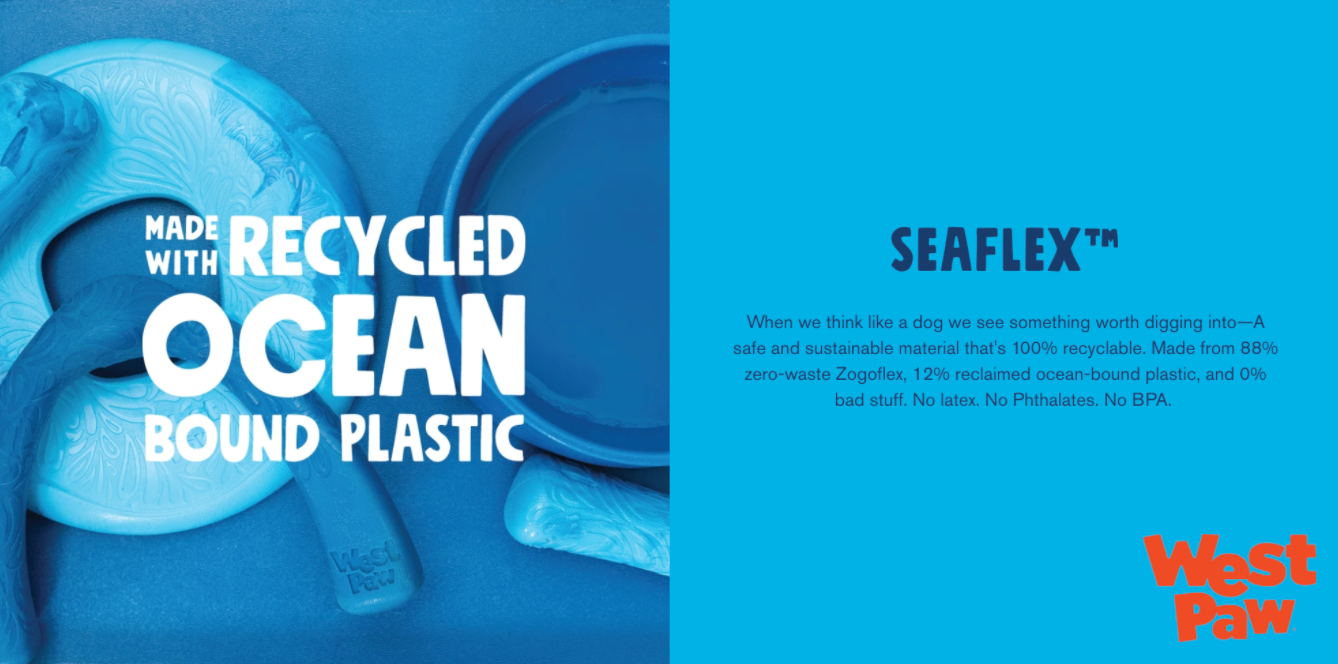Dog lovers have no shortage of options when it’s time to give Fido something new to fetch, so brands are always looking for ways to differentiate themselves and appeal to different parts of the $2.5 billion dog toy market. However, standing out from the crowd has never been difficult for West Paw.
The certified B Corporation headquartered in Bozeman, Montana, has been outfitting pets and their owners with eco-friendly products since 1996. The family-owned and operated business developed its own proprietary TPE, or thermoplastic elastomer formula—Zogoflex—to create zero-waste dog toys and accessories that can be used, loved, returned, turned into pellets and then recycled once they’ve outlived their original lives.
Zogoflex will sit nicely in West Paw’s sustainability portfolio, nestled next to items like their dog beds, stuffed with IntelliLoft—made from 100% recycled plastic bottles—and their leashes also made from recycled content. This track record of sustainability-driven innovation has created a loyal following among dog owners that want the best for their four-legged friends and the environment.
The Challenge(s)
While West Paw’s product line already features an extensive slate of carefully crafted products featuring recycled raw materials, West Paw wanted to up the ante. By using recycled plastic, they could help remove waste from shorelines and make beaches and fishing areas cleaner and safer. Not only would this make a net positive environmental impact, but it would serve as an excellent vehicle to bring attention to the ocean pollution cause. So while setting the sustainability initiatives was the easy part, implementing the sustainability goals in higher performance applications would be the slightly more difficult part. Luckily, the team at WestPaw was steadfast in their determination to be part of the solution, rather than a contributor to the problem.
Because their products are gnawed on and come in frequent contact with food and water destined for the tummies of thousands of pets, safety and durability were an all-time priority. The owners entrusting their pets’ health and wellbeing to West Paw would have zero tolerance for any ill effects derived from using their products. So set forth was the challenge; create a fun, eco-friendly, durable, and safe dog toy… easier said than done.
The solution highlighted the need for compounding, the act of blending plastics with other additives to create higher quality engineered materials. The products would need to be expertly formulated with the right mix of materials to create a non-toxic, safe solution that satisfied their sustainability goal as well as met their robust quality standard. To find just the right materials and hone their marketing messages, West Paw partnered with a leading compounding organization to explore Oceanworks materials and assist on the (very technical) next leg of their sustainability journey.
The Process
After determining Oceanworks plastic was the right material for the sustainability campaign, the West Paw team and their compounding partner immediately focused on finding the perfect material for their ocean plastic product line. In this case, High Density Polyethylene, or HDPE, proved to be the best fit for this very specific application due to its durability, resistance to moisture, and food grade quality.

Tapping into Oceanworks extensive portfolio of resins, West Paw and Oceanworks focused on Mexico and the Caribbean for material collection sources. By being able to select materials from a global portfolio, the supply chain was able to stay as tight as possible, maximizing the sustainability objectives.
Combining all of these goals and specifications together, the compounder was brought in to find the perfect proportions for the mix of ocean plastic and West Paw’s trusty Zogoflex material. In the end, 12.5% ocean plastic was the magic ratio for products that didn’t compromise the quality and durability.
Of course building awareness and attracting customers is the other part of the equation for introducing any sustainable product. To put its ocean plastic contents at the forefront, West Paw leaned on the Oceanworks marketing team to execute a custom dog themed media shoot in the exact location their ocean plastic was being sourced from. With bespoke media in hand, West Paw dubbed their new product line Seaflex, highlighting its origin and creating a sub-brand it can now promote widely. The campaign even includes video featuring Seaflex products (and dogs!) on the same beaches being helped by their ocean plastic initiative.

The Results
West Paw has created five new toys and accessories as part of its Seaflex product line. Featuring items like the Snorkl, which is great for chewing and tugging, the Drifty which features a traditional dog bone-style shape and the Sailz, which borrows its shape from disc golf for a toy that will soar far enough to keep active canines busy pursuing and retrieving their new favorite toy.

All the items are tough enough for whatever punishment pooches unleash upon them and are dishwasher safe. Seaflex toys and accessories hit the market boasting a distinguishing swirled look that makes each product a unique work of art. The items come in several colors (red, blue, and green) while the no-slip bowls and placemat are available in blue or grey.
Every one of their products is recyclable through West Paw’s Join the Loop program, and during its first year the company anticipates preventing the equivalent of 26,000 plastic milk jugs from entering the ocean ecosystem.
Introduced in June 2021, the entire Seaflex product line is now available for purchase and each sale helps take a bite out of the ocean plastic problem.